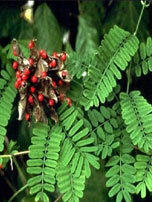SHAHEED KARTAR SINGH SARABHA AYURVEDIC MEDICAL COLLEGE & HOSPITAL
Affiliated to Guru Ravidas Ayurved University, Hoshiarpur Punjab
Affiliated to Guru Ravidas Ayurved University, Hoshiarpur Punjab

Botanical Name : Abrus precatorius
Family : Fabaceae
Introduction :
Size and weight of this seeds used for compare weight. seed and roots of white variety usually uses. Abrus = delicate leaves, precatorius = of prayers = seeds of this plant are used for making rosaries
Names in different Indian languages :
English : Indian Wild Liquorice, Jequirity, Crab’s Eye, Precatory Bean.
Hindi : Gunci,batti,gunacaci
Kannada : Gurugunji
Malayalam : kunni
Sanskrit : Gunja
Tamil : Kuntumani, kunri
Telugu : guruginja
Synonyms :
Gunjaa, Gunjaka, Chirihintikaa, Raktikaa, Chirmiti, Kakanti, Kabjaka, Tiktikaa, Kaakananti, Kaakchinchi , Choodamani Raktaphalika, Kakanantika, Kakachinchi, Krushnaraktika
Morphology :
A creeper with many branches.
Leaves resemble tamarind leaves, pinnate, having 20-40 leaflets, leaflets oblong
flowers are pink, bluish and appear in cluster.
Fruit: pod, Legumes are 1.5 – 3.5 cm, long containing red, white and black coloured dseeds. Red coloured or white coloured seeds have black spot on their tips.
Root and leaves are sweet. It is 3 varieties – white , red and black (roots and leaves of all these 3 varieties are used in medicines). A small woody twiner with a long, woody, tortuous branched root reaching inch or more in diameter. Stems slender, cylindrical, branched, with a smooth or wrinkled, brown bark. Leaves alternate, shortly stalked, spreading, 2—6 inches long, abruptly pinnate, stipules small, subulate; leaflets on very short pilose petioles, opposite, in about 8—15 closely placed pairs, inch long, oblong, very blunt at both ends, but often apiculate at the truncate apex, entire, thin, smooth on both sides, articulated and readily falling, with two minute stipell at the base of each pair. Flowers small, shortly stalked, in small clusters arranged on large tuberosities along the outer side of a stiff curved rachis, and forming a secund racemose inflorescence terminating a thick, horizontal branch which is naked above, but usually with several closely placed leaves near the base. Calyx small, cup-shaped, truncate at the mouth, with 5 very shallow teeth, membranous, finely pilose. Corolla papilionaceous, rose- coloured, standard ovate, erect, with a short broad claw, wings narrow, falcate-oblong, keel-petals united except the claws, longer than the wings. Stamens 9, the filaments united into a split sheath, the free portions with 5 longer ones alternating with 4 shorter, anthers uniform. Ovary shortly stalked, very small, downy; style curved glabrous, stigma capitate. Pod about I inch long, broadly oblong, shortly beaked, somewhat compressed, 2-valved, with imperfect septa between the seeds. Seeds 4—6, globular-ovoid, about inch long, testa hard, bright and shining, brilliant scarlet, with a black patch at one end round the hilum, cotyledons plane-convex, no endosperm.
Distribution & Habitat :
All over India
Chemical constituents :
abrin, a toxalbumin,indole derivatives, anthocyanins, sterols, terpenes,
The roots contain precol, abrol, glycyrrhizin and alkaloids—abrasine and precasine. The roots also contain triterpenoids—abruslactone A, methyl abrusgenate and abrusgenic acid.
Properties :
Seed
RASA-tikta, kashaya;
GUNA-laghu, ruksha, tikshna;
VIRYA-ushna
VIPAKA-katu
Root : madhur and snigdha.
Karma – vatha pitha hara
Srotogamitva :
Dosha: Kaphavata (seed). tridoshasamak (leaves and roots).
Dhatu: Muscles (hoarseness of voice – milk boiled with the leaves); shukra (milk boiled with the leaves – aphrodisiac).
Mala: Mutra (dysuria – milk boiled with leaves), keshya – enhances hair growth.
Indication :
Uterine stimulant, abortifacient, toxic, skin disease, alopecia, leucoderma, asthma, stomatitis
Seeds—teratogenic. A paste of seeds is applied on vitiligo patches.
Part used :
Root and seeds
Dosage :
Seed powder. 1 to 2 ratti: root powder – 0.5 to 1 gm
Internal uses :
Digestive system:
Purgative, gastric irritant , emetic
Renal System:
Diuretic
Therapeutic Uses :
Seeds ground in a paste are applied over skin disorders, dermatoses. chronic ulcers and alopecia. Paste of the leaves is applied over inflammations and wounds. Oil boiled with the leaves is used for massage in vata disorders. Nasya of powdered seeds is given in headache. Milk boiled with the leaves is given in hoarseness of voice, impotency, dysuria and general debility. Powdered seeds in excess dose causes toxic symptoms like cardiac arrest etc. Seeds are purified by boiling them in kanji or cows milk for three hours
Important Yogas or Formations :
Swetha gunjadi gulika
